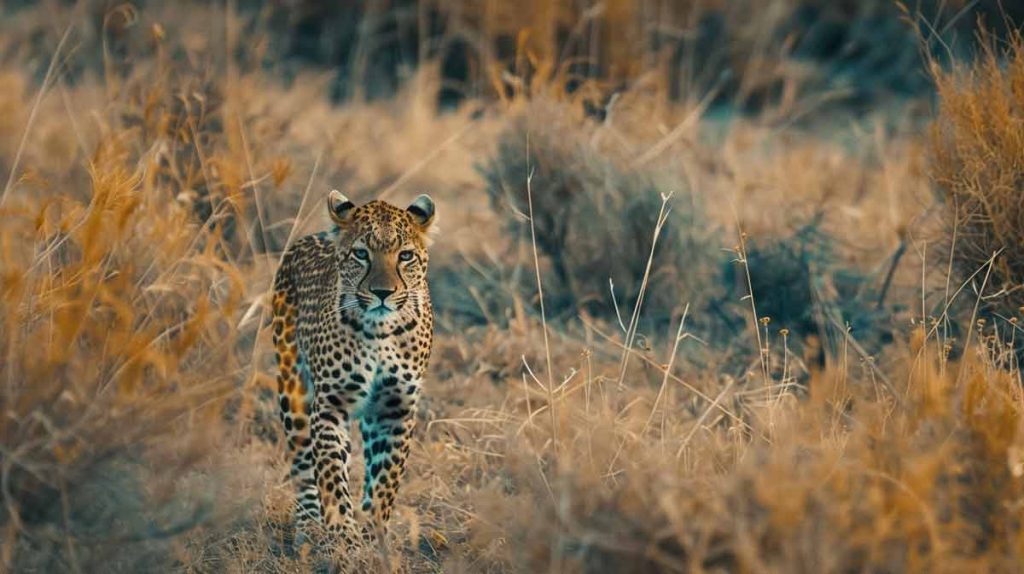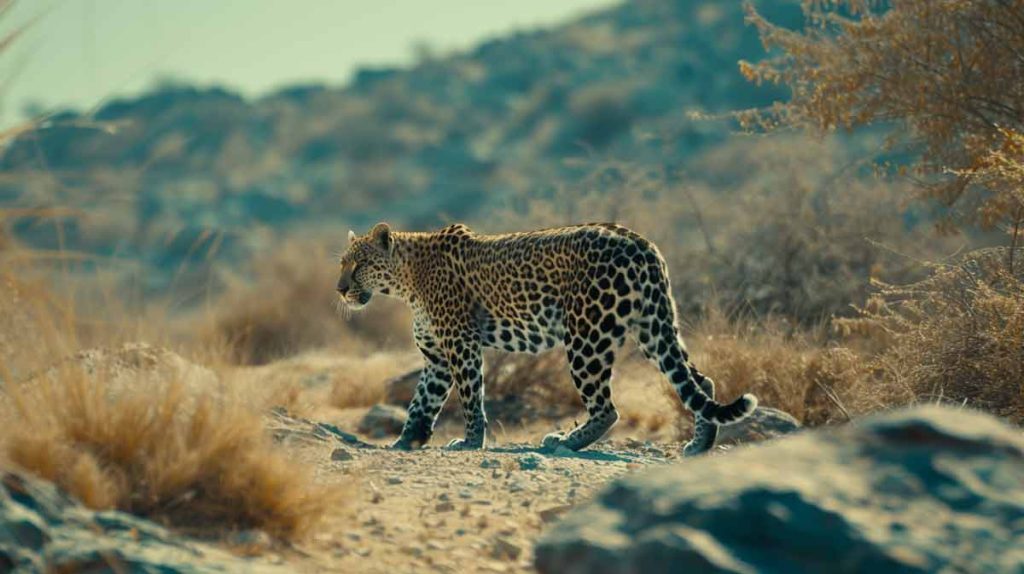Did you know that leopards, the stealthy and powerful big cats, have one of the most varied diets among all predators? They are not picky eaters and can consume a wide range of prey, from insects to larger ungulates. Understanding their food preferences and hunting habits gives us a fascinating insight into the world of these majestic creatures.
Key Takeaways:
- Leopards have a diverse and carnivorous diet, eating a variety of prey in the wild.
- Their food preferences include insects, fish, ungulates, and smaller animals such as rodents and birds.
- Leopards are skilled hunters and use stalking, ambush, and scavenging as their hunting strategies.
- Habitat loss, poaching, and human-wildlife conflict threaten leopard populations.
- Conservation efforts are crucial for protecting leopards and ensuring their survival in the wild.
The Variety of Prey in a Leopard’s Diet
Leopards have an extensive range of prey that varies depending on their habitat. Their diet consists of diverse animals, including ungulates such as impala, gazelle, kudu, and duiker. Additionally, leopards feed on insects, fish, rodents, reptiles, birds, and beetles, showcasing their adaptability and versatility as hunters. They are opportunistic feeders, which means they can scavenge for food when the opportunity arises. This adaptability allows them to thrive in different environments, ranging from lush rainforests to expansive savannahs.

Leopards’ natural feeding behaviour revolves around hunting and capturing their prey. They possess remarkable agility and strength, enabling them to stalk, chase, and capture various animals. Their stealthy approach allows them to sneak up on their unsuspecting targets while their powerful jaws deliver a swift and lethal bite to the prey’s throat or neck, ensuring a quick kill.
“Leopards can track their prey over long distances before launching their attack. Their camouflage coat effectively blends them into the surroundings, allowing them to approach their prey undetected,” explains Dr Mark Davidson, a wildlife expert at the Conservation Society.
The Importance of Leopard Nutrition
Leopards’ dietary needs are met through their consumption of various prey species. Their diet provides them with essential nutrients for their overall health and well-being. Different prey items offer a range of nutrients, such as proteins, fats, vitamins, and minerals, ensuring that leopards receive a balanced diet in the wild.
| Prey | Nutritional Value |
|---|---|
| Ungulates (impala, gazelle, kudu, duiker) | High in proteins and fats |
| Insects | Rich in proteins and micronutrients |
| Fish | Source of omega-3 fatty acids and minerals |
| Rodents | Good source of proteins and fats |
| Reptiles | Provide essential nutrients and vitamins |
| Birds | Supply high-quality proteins and fats |
| Beetles | Offer nutritional diversity and micronutrients |
These various food sources provide the necessary nutrition for leopards to survive and support their energy requirements for hunting, reproduction, and maintaining their territories.
Hunting Habits and Techniques of Leopards
Leopards are known for their impressive hunting abilities. They employ two primary strategies when on the prowl: stalking and ambush. Their hunting behaviour showcases their remarkable adaptability and agility in capturing prey.

Stalking: The Art of Patience and Precision
Leopards exhibit exceptional patience when stalking their prey. Utilizing their acute sense of hearing and excellent eyesight, they meticulously observe and track potential targets, blending seamlessly into their surroundings. This patient approach allows them to study their prey’s movements, ensuring a successful attack.
“The leopard, having stealthily closed the gap between itself and its target, launches its attack with calculated precision.”
The leopard’s stealthy nature and ability to move silently enable it to close in on prey without being detected. With a final burst of speed, typically within a range of five meters, the leopard executes a sudden pounce, aiming to immobilize its prey swiftly. The target areas are often the throat or neck, targeting vital areas for quick dispatch.
Ambush: Mastering the Element of Surprise
Leopards are masters of the ambush, expertly using their surroundings to their advantage. They select strategic locations, such as dense vegetation or elevated positions, to remain hidden and undetected. When the opportunity presents itself, the leopard emerges from its concealed position, catching its prey off guard and leaving little chance for escape.
The leopard’s camouflage coat further enhances its effectiveness during an ambush, enabling it to blend seamlessly with the surrounding environment. This exceptional adaptation allows the leopard to approach prey undetected, maximizing the element of surprise.
| Hunting Strategies | Characteristics |
|---|---|
| Stalking | Patience, precision, acute senses, blending into surroundings |
| Ambush | Stealth, camouflage, strategic positioning, element of surprise |
The leopard’s hunting habits and strategies demonstrate a combination of skill, intelligence, and adaptability. Whether it’s patiently stalking its prey or launching an ambush from concealment, the leopard’s hunting prowess is a testament to its remarkable survival capabilities in the wild.
Conservation Efforts and Threats to Leopard Populations
Leopards, magnificent wild creatures, face numerous threats to their populations, primarily due to human activities. The encroachment of human settlements and the consequent habitat loss and fragmentation have significantly reduced their range. This loss has disrupted their natural hunting and breeding patterns, risking their populations.

Another significant danger to leopard populations is the commercial bushmeat trade, which has caused a decline in their prey populations. As their natural food sources decrease, leopards are forced to compete for shrinking resources, making it challenging to find adequate nourishment.
Poaching for their luxurious fur and human-wildlife conflict resulting from leopards preying on livestock are additional significant concerns affecting leopard populations. These conflicts often lead to retaliatory killings by farmers whose livelihoods are at stake.
Fortunately, various conservation efforts have been initiated to protect and restore leopard populations. Establishing national parks and protected areas ensures the preservation of their habitats and provides an environment where they can thrive. Additionally, effective law enforcement helps tackle illegal activities such as poaching and the trade of leopard products.
However, despite these efforts, the conservation status of leopards remains a matter of concern. Continued dedication to protecting these magnificent creatures is crucial to ensuring their survival in the wild. By raising awareness about the threats they face and promoting coexistence between humans and leopards, we can contribute to the long-term preservation of their populations and protect the delicate balance of our ecosystems.
FAQ
What do leopards eat in the wild?
Leopards are carnivores with diverse diets, including antelope, baboons, hyenas, and even smaller mammals like hares and porcupines. They are opportunistic hunters and will consume whatever is available in their territory.
Where do leopards live?
Leopards are highly adaptable and can be found in various habitats, including savannas, grasslands, deserts, and even semi-desert areas. They are native to Africa and Asia and various subspecies in different regions.
How do leopards hunt?
Leopards are solitary and nocturnal hunters, using their keen senses and stealth to stalk and ambush their prey. They are also known for their ability to drag their kills up into trees to protect them from scavengers like hyenas and lions.
Do leopards like to hunt in groups?
No, leopards are solitary creatures and typically hunt and feed alone. However, female leopards may teach their cubs to hunt and sometimes share a meal.
What are the typical prey of leopards?
Leopards typically hunt and consume a wide range of animals, including smaller mammals like hares and larger prey such as impalas, warthogs, and ungulates like antelope and deer.
Where are leopards commonly found?
Leopards are commonly found in various regions across Africa and Asia, including the savannas of East Africa, the forests of Central and West Africa, and the mountainous terrains of Central and South Asia.
What are the threats to leopards in the wild?
Leopards face several threats in the wild, including habitat loss, poaching, and conflicts with humans. They are also endangered due to the illegal wildlife trade and the loss of their natural prey.
How often do leopards eat?
Adult leopards typically eat every 3-4 days, but this can vary based on food availability in their territory. When food is scarce, leopards can survive for long periods without eating.
What is the role of leopards in the food chain?
Leopards are top predators that play a crucial role in the food chain. They help control the population of herbivores and contribute to the balance of their ecosystems. They are known to keep the numbers of prey species in check, preventing overgrazing and maintaining the ecosystem’s health.
